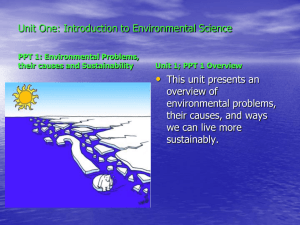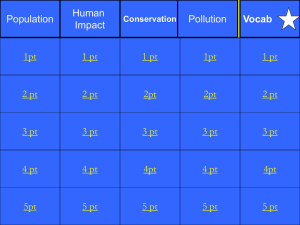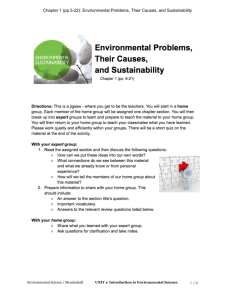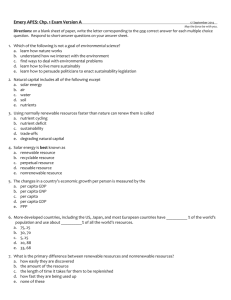ap environmental science
advertisement
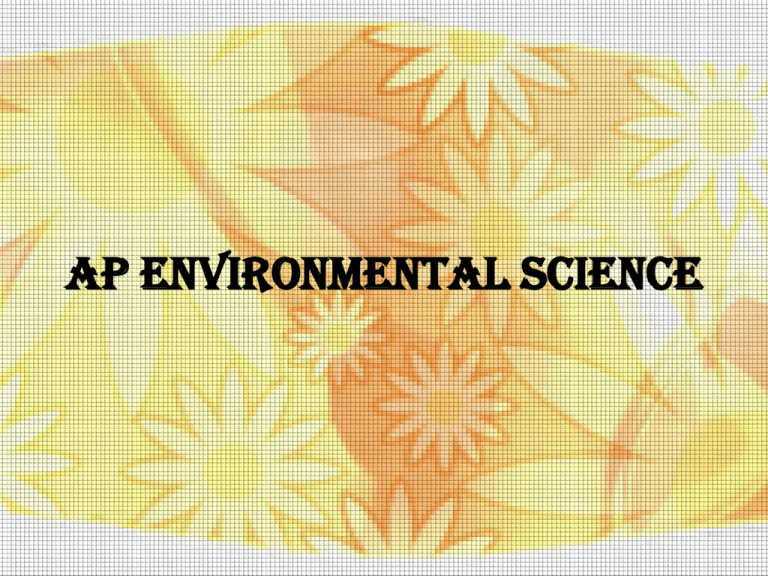
AP ENVIRONMENTAL SCIENCE AP ENVIRONMENTAL SCIENCE - APES Environmental Science is the study of how the earth works, how we interact with and affect the environment, and how to deal with environmental problems. Environmental Problems, Their Causes, and Sustainability Chapter 1 • 1-1 What Is an Environmentally Sustainable Society? • 1-2 How Can Environmentally Sustainable Societies Grow Economically? • 1-3 How Are Our Ecological Footprints Affecting the Earth? • 1-4 What Is Pollution and What Can We Do about It? • 1-5 Why Do We Have Environmental Problems? • 1-6 What Are Four Scientific Principles of Sustainability? Each chapter begins with a case study. • Living in an Exponential Age • Impact of human exponential growth on – Loss of animal and plant species – Loss of resources 13 12 11 ? 8 7 6 5 Billions of people 10 9 4 3 Industrial revolution 2 1 Black Death—the Plague 2–5 million years 8000 Hunting and gathering 6000 4000 0 2000 2100 2000 Time B. C. A. D. Agricultural revolution Industrial revolution Fig. 1-1, p. 5 1-1 What Is an Environmentally Sustainable Society? • Concept 1-1A Our lives and economies depend on energy from the sun (solar capital) and on natural resources and natural services (natural capital) provided by the earth. • Concept 1-1B Living sustainability means living off the earth’s natural income without depleting or degrading the natural capital that supplies it. Environmental Science Is a Study of Connections in Nature • Interdisciplinary science connecting information and ideas from – Natural sciences, with an emphasis on ecology – Social sciences – Humanities Environmental Science Is a Study of Connections in Nature • How nature works • How the environment affects us • How we affect the environment • How to deal with environmental problems • How to live more sustainably Environmental Science: the interdisciplinary study that examines the role of humans on earth; includes the disciplines of -chemistry -economics -politics -ethics -biology -geology Sustainability • The Central Theme of our book • Definition: the ability of a specified system to survive and function over a specified time • Critical component Natural Capital The untapped raw material and natural resources that a country holds. Natural Capital Includes: 1) Natural Resources: Materials and energy in nature….essential to humans. A) Renewable: air, water, soil B) Nonrenewable: copper, oil, and coal 2) Natural Services: functions of nature…..support life and human economies Ex. Nutrient cycles We get both from our ecosystem for FREE!!! Organic matter in animals Dead organic matter Organic matter in plants Decomposition Inorganic matter in soil Fig. 1-4, p. 9 Environmentally Sustainable Societies Protect Natural Capital and Live off Its Income • Our lives and economies depend on energy from the sun (solar capital) and on natural resources and natural services (natural capital) provided by the earth. • Living sustainability means living off the earth’s natural income without depleting or degrading the natural capital that supplies it. 1-2 How Can Environmentally Sustainable Societies Grow Economically? • Concept 1-2 Societies can become more environmentally sustainable through economic development dedicated to improving the quality of life for everyone without degrading the earth's life support systems. There Is A Wide Economic Gap Between Rich And Poor Countries • Country’s economic growth: measured by gross domestic product (GDP) • Changes in economic growth: measured by per capita GDP • Purchasing power parity (PPP) plus GDP are combined for per capita GDP PPP • Compare developed with developing countries Economic Growth • provides people with goods & services needed • GDP (Gross Domestic Product) a.k.a. Gross National Income (GNI) – market value for goods and services produced in a country • Per Capita GDP – used to measure the standard of living; GDP divided by the total population at midyear • Economic Development – improving the standards of living in a country through growth of economies. Economic Development Developed Countries- high industrialization; high per capital GDP (Europe, US, Canada, Japan) Developing Countries- moderate to low per capital GDP and levels of industrialization (India, parts of Africa and South America); represent 97% of the projected increase in the world population. Positive and Negative Aspects of Economic Development Positive: Longer life expectancy Decrease in infant mortality Greater food production than actual food needs (abundance) Decrease in air/water pollution Decrease in poverty overall Negative: - high infant mortality (8 x’s higher than developed nation) - High pollution levels - Soil, water and forest resources are rapidly depleted affects future food production - wages are very low with poor working conditions - shorter life expectancy Percentage of World's: 18% Population 82% Population 0.12% growth 1.46% 77 years Life expectancy Wealth and income Resource use Pollution and waste 67 years 85% 15% 88% 12% 75% 25% Developed countries Developing countries Fig. 1-5, p. 11 The Gap Between These is Widening Economically and Socially • Developed Countries • 1.2 billion people • Us, Canada, Japan, Australia, New Zealand, most European countries • Developing Countries • 5.4 billion people • Most in Africa, Asia and Latin America • China, India, Brazil, Mexico WHAT DO YOU REMEMBER???? 1. Name the 2 types of natural capital and 2 examples of each. 2. What is the central theme of the book? 3. Why is ES an interdisciplinary science? 4. Name 2 advantages and 2 disadvantages of economic development. 5. Give 3 major differences between developing and developed nations. 6. What does “per capita” mean? 1-3 How Are Our Ecological Footprints Affecting the Earth? • Concept 1-3 As our ecological footprints grow, we are depleting and degrading more of the earth’s natural capital. Resources • Resource- anything obtained from the environment to meet our needs. – Directly available for use like air, wind, water and wild edible plants – Not directly available for use would be petroleum, copper, groundwater and modern crops. • Perpetual resource – Solar energy Some Sources Are Renewable Renewable resource- resources that can be renewed through natural processes. Examples are forests, grasslands, fresh air, fertile soil. Sustainable yield -the highest rate at which a renewable resource can be used indefinitely without reducing its available supply Environmental degradation – when the supply of a resource is reduced because we have exceeded the replacement rate. Some Resources Are Not Renewable • Nonrenewable resources – exist in fixed quantities – Energy resources – oil, coal – Metallic mineral resources – Al, Cu – Nonmetallic mineral resources- sand, salt • • • • Reduce Reuse Recycle Refuse Resources Perpetual Direct solar energy Nonrenewable Winds, tides, flowing water Fossil fuels Metallic minerals Nonmetallic minerals (iron, copper, aluminum) (clay, sand, phosphates) Renewable Fresh air Fresh water Fertile soil Plants and animals (biodiversity) Common Resources- think about it! • What are some common resources that must be shared? • Are resources distributed equally around the world? • Are resources shared equally? • Do resource-rich countries have an obligation to share with resource-poor countries? Overexploiting Shared Renewable Resources: Tragedy of the Commons • Three types of property or resource rights – Private property – Common property (1/3 of all land in US is owned by the people and managed by the government) – Open access renewable resources- use is regulated by government (open oceans /fish and clean air) Garrett Hardin and the Tragedy of the Commons Overuse of common property resources, which are owned by no one but available to everyone free of charge. Examples are clean air, oceans, fish, Antarctica. This leads to exploitation and then no one can use the resource. “ If I don’t use this resource then someone else will, the little bit I pollute is not enough to matter” Footprints • What is an ecological footprint? • Is the world’s footprint growing or shrinking? • What happens to the resources as the footprint changes? What Is An Ecological Footprint? • Amount of productive land and water needed to supply the people in an area with resources to live and the community’s ability to absorb and recycle the wastes and pollution they produce by using resources. • Per capita ecological footprint - the average ecological footprint of an individual in a given area. How Is The Planet’s Ecological Footprint? • In 2003, the World Wildlife Fund and Global Footprint Network estimated that the global ecological footprint exceeded the earth’s biological capacity by about 25% but it was 88% in the world’s high-income countries. • American’s are the second largest consumers of resources, and if everyone could use resources the way we do, the Earth could only support 1.3 billion people. Ecological Footprints • Currently, each person’s ecological footprint is 20% greater than can be sustained indefinitely. • The consumption of the U.S. alone would require 4 more planet Earths just to sustain the current population! This does not account for the future population! HUGE FOOTPRINT = OVERCONSUMPTION! Case Study: China’s New Affluent Consumers • Affluence- the rapid unsustainable consumption of resources associated with lifestyles of citizens in developed countries. • Leading consumer of various foods and goods – Wheat, rice, and meat – Coal, fertilizers, steel, and cement • Second largest consumer of oil (after the US) As of June, 2011, the current population of China was 1,336,391,137 and they are adding 44,000 people every day! (In 1950, the population in China was 562,579,779) (population #s found at geohive.com) Case Study: China’s New Affluent Consumers- what happens? • Two-thirds of the most polluted cities are in China • Projections, by 2020 – Largest consumer and producer of cars – World’s leading economy in terms of GDP PPP China’s population is expected to reach 1.5 billion by 2033. If it reaches this number, then China will need two-thirds of the world’s current grain harvest, twice the world’s current paper consumption, and more than the current global production of oil. Could these needs be met? Cultural Changes Have Increased Our Ecological Footprints • 12,000 years ago: hunters and gatherers • Three major cultural events – Agricultural revolution- 10-12,000 y.a. – Industrial-medical revolution- 275 y.a. – fossil fuels – Information-globalization revolution- 50 y.a. Homework for tonight Calculate your ecological footprint! Do you think you have a large or small footprint? If everyone lived your lifestyle, how many earths would we need? Find out by going to the following website: http://www.footprintnetwork.org/en/index.php/GF N/page/personal_footprint/ complete the quiz, and print out the last page where you learn how many earths you would need, and then answer the questions under assignments on my website. 1-4 What Is Pollution and What Can We Do about It? • Concept 1-4 Preventing pollution is more effective and less costly than cleaning up pollution. Sources of Pollution • Point – single, identifiable source (cars/industrial plants); easy to identify and control • Non- point- dispersed and hard to pinpoint the source (pesticides sprayed into the air or in the water through run off) • This picture is an example of _____ pollution. Types of Pollutants • Biodegradable Pollutants: materials that decompose through the actions of bacteria, fungi, and other living organisms. (Natural Processes) • Nondegradable Pollutants: material that is not broken down by natural processes. Some, like the heavy metals, create problems because they are toxic and persistent in the environment. Others, like synthetic plastics, are a problem because of their sheer volume. We Can Clean Up Pollution or Prevent It • Pollution cleanup (output pollution control) • Pollution prevention (input pollution control) What Do You Remember??? 1. To what does “sustainable yield” refer? 2. Give 2 examples of “commons.” 3. What can we learn from the Tragedy of the Commons? 4. Compare the ecological footprint of an average American to that of a person in India. 5. What 3 cultural events that led to an increase in our ecological footprint. 6. Give an example of both point and nonpoint pollution. 1-5 Why Do We Have Environmental Problems? 1. Population growth 2. Wasteful and unsustainable resource use 3. Poverty 4. Failure to include the harmful environmental costs of goods and services in their market prices 5. Insufficient knowledge of how nature works Causes of Environmental Problems Population growth Unsustainable resource use Poverty Excluding Trying to manage nature environmental costs without knowing enough from market prices about it Fig. 1-12, p. 18 Poverty Has Harmful Environmental and Health Effects • Population growth affected – have more children to support the family • Malnutrition – lack of protein and other nutrients • Premature death – 7 million die each day, with 2/3 being children under the age of 5 • Limited access to adequate sanitation facilities and clean water (38% lack access) Lack of access to Number of people (% of world's population) Adequate sanitation facilities Enough fuel for heating and cooking Electricity 2.6 billion (38%) 2 billion (29%) 2 billion (29%) Clean drinking water 1.1 billion (16%) Adequate health care 1.1 billion (16%) Adequate housing Enough food for good health 1 billion (15%) 0.86 billion (13%) Fig. 1-13, p. 18 Affluence Has Harmful and Beneficial Environmental Effects • Harmful environmental impact due to – High levels of consumption – Unnecessary waste of resources • Affluence can provide funding for – Developing technologies to reduce • Pollution • Environmental degradation • Resource waste Prices Do Not Include the Value of Natural Capital • Companies do not pay the environmental cost of resource use • Goods and services do not include the harmful environmental costs • Companies receive tax breaks and subsidies • Economy may be stimulated but there may be a degradation of natural capital Different Environmental Worldviews • Planetary Management Worldview: we are apart from the rest of nature, We are the most important, Because of our technology we will never run out of resources, Economic growth is unlimited and we should use earth’s resources for our benefit • Stewardship Worldview: can and should manage Earth for our benefit...we should be stewards to the earth, Manage earth’s life support system, We most likely will not run out of resources but they should not be wasted • Environmental Wisdom Worldview: we are part of and dependent on nature, nature exists for all species (not just humans), We are dependent on nature, Don’t waste resources, Success depends on how well we learn how nature sustains itself We Can Learn to Make Informed Environmental Decisions • Scientific research • Identify problem and multiple solutions • Consider human values Identify an environmental problem Gather scientific information Propose one or more solutions Project the short- and long-term environmental and economic advantages and disadvantages of each solution Decide on and implement a solution Evaluate the consequences Revise decision as needed Fig. 1-15, p. 21 Connection Between Consumption And Environmental Problems • Affluenza- unsustainable addiction to overconsumption and materialism (US and other developed countries) • However, not all affluent countries have to degrade the environment. These countries have more money to create new technologies that can help improve environmental quality. • Environmental impact (I) can be calculated based on 3 main factors: P= population of people A= affluence (average resource use per person) T= impact of technologies per unit of resource consumption I= P x A x T Environmental Impact I=PxAxT Case Study: The Environmental Transformation of Chattanooga, TN • Environmental success story: example of building their social capital • 1960: most polluted city in the U.S. • 1984: Vision 2000 • 1995: most goals met • 1993: Revision 2000 Individuals Matter: Margaret Mead • Anthropologist (1901-1978)the study of the biological, cultural, social and origin of humanity. • 5–10% of the population can bring about major social change “A small group of thoughtful people could change the world. Indeed, it's the only thing that ever has.” Individuals Matter: Aldo Leopold Aldo Leopold: (1887-1948) environmental ethics – A leader of the conservation and environmental movements of the 20th century • Land ethic • Father of wildlife management – Wrote: A Sand County Almanac – "We abuse land because we regard it as a commodity belonging to us. When we see land as a community to which we belong, we may begin to use it with love and respect. ~Aldo Leopold, A Sand County Almanac" INDIVIDUALS MATTER: Rachel Carson • Biologist • Silent Spring – 1962 • Brought attention to the wide use of pesticides and their potential harm to people and the environment. 1-6 What Are Four Scientific Principles of Sustainability? • Concept 1- 6 Nature has sustained itself for billions of years by using solar energy, biodiversity, population control, and nutrient cycling—lessons from nature that we can apply to our lifestyles and economies. Reliance on Solar Energy Nutrient Cycling Biodiversity Population Control Fig. 1-17, p. 23 Current Emphasis Sustainability Emphasis Pollution cleanup Pollution prevention Waste disposal (bury or burn) Waste prevention Protecting species Protecting habitat Environmental degradation Environmental restoration Increasing resource use Less resource waste Population growth Population stabilization Depleting and degrading natural capital Protecting natural capital Fig. 1-18, p. 24 It is estimated that we have 50-100 years to make changes in our lifestyles and economies in order to maintain sustainability. What changes do you think are necessary? Are we obligated to make these changes? What’s the use of a house if you don’t have a decent planet to put it on? -HENRY DAVID THOREAU -
